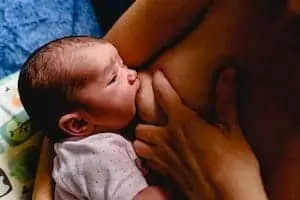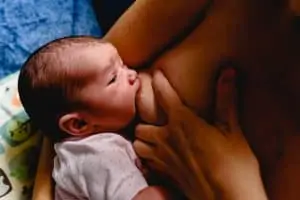Breastfeeding is different for all women, and at one time, you might realize that your breasts aren’t producing the same amount of milk. Many women recognize at some point that one breast makes more milk than the other.
What gives? Do you really have a slacker boob?
Yes! It’s a thing. Believe it or not, humans aren’t perfectly symmetrical, so it’s not unusual to have one breast that is larger than the other. That means it shouldn’t be a surprise to find one breast produces less milk than the other.
It’s common; most breastfeeding mothers, myself included, can tell you which boob produces more than the other. As long as your baby is gaining and growing sufficiently, there is no reason to be worried about your slacking breast.
However, if you feel a bit concerned with the discrepancy in your milk supply, let’s look at why this happens and if you can do anything to even out your production.
Is It Normal for One Breast to Produce More Milk than The Other?
Yes! It’s not unusual for women to have an uneven breast milk supply, sometimes called lopsided breastfeeding. For some women, the difference is small, but the difference is that supply amounts can be visible in your breast size for other women.
Here are some reasons that you might have a high or low milk supply in one breast than the other.
Different Amounts of Breast Tissue
You won’t have any idea until you start to breastfeed if you have more milk-making breast tissue in one breast than the other. You might have different sized milk ducts in your breast, causing a low milk supply in one breast.
There is nothing you can do to change it when it comes to this issue, but it might be why you have one breast not producing enough milk. Thankfully, the opposite breast is fully capable of picking up the difference, so don’t feel like you need to supplement it.
A More Forceful Letdown
You might have one breast that has a more forceful letdown than the other one. That could cause your baby to pull away, gag, or struggle to keep up. On the other hand, your breast with less forceful letdown could cause frustration when your baby is hungry and ready for milk.
Your Baby’s Preference

Believe it or not, your baby could have a preference; this happened to be with two of my kids. Whether they prefer how it feels to latch or it might be more comfortable, some babies have a side they like and deviate more to than the other side.
This is typically okay as long as your baby has no birth injuries, or it doesn’t happen all of a sudden with your baby entirely rejecting a particular breast. Make sure your baby doesn’t have an ear infection because that can cause a sudden breast rejection.
Mom’s Preference
You might not realize it, but you also might have a preference. In the beginning, you focus on equally alternating breasts, and then, over time, you might find yourself giving your baby your “favorite” breast.
Mastitis
If you have mastitis, you might notice a drop in milk production on the one side. This also can happen if you have a clogged duct.
It’s also believed that your baby might not like the taste of the milk coming out of a breast with mastitis. Some babies don’t care about a different flavor, but some will, so this is something to consider if the preference happens suddenly.
Previous Breast Trauma
Have you had previous breast surgery? Perhaps you’ve had an injury to your breast tissue. These types of trauma can reduce your milk supply. If the trauma happens while you’re nursing, you might find that you have one breast producing less milk suddenly.
Is It Possible for One Breast to Dry Up?
Absolutely, but you will need to do so intentionally in most cases, but it could happen without that being your goal.
For my last two kids, I intentionally dried up one breast, leaving only one for nursing. I did so because once my child was one-year-old, they could sufficiently receive enough milk from only one breast. I picked the breast that created the most milk and gradually decreased taking milk by the slacker boob.
Yes, this does lead to uneven breasts while breastfeeding. Don’t worry; once you wean entirely, your breasts will become even again. Until then, you have to deal with the slightly lopsided look.
How Do I Increase Milk Supply in One Breast?
As long as your baby receives adequate breast milk and grows at an appropriate weight, you don’t need to worry about your left or right breast, not producing milk at the same rate. However, if it bothers you or you need more milk for your child, you have to figure out how to increase milk supply in one breast. That can be tricky, but it can be done. One way is to consume more lactogenic foods.
Here are some more suggestions.
Start with Your Slacker Boob
When a mother asks how she can even out her breast size while breastfeeding, the first tip should be to start with your slacker or smaller breast first each time. Babies nurse less vigorously on the second breast, so it won’t encourage a higher supply. Also, starting with that breast each time enables your body to send more to meet your baby’s demand.
Favor Your Slacker Boob
You need to give more love to your breast with the lower supply during each feeding; it can’t be a one-time deal. It has to continue to make a real difference. Nursing frequently on that side will increase your supply.
However, you still need to pay attention to the breast with a higher amount of milk. Since that breast has more milk, it can cause engorgement, plugged ducts, and mastitis.
Hand Massage While Breastfeeding
While you’re nursing on your lower-producing breast, take the time to massage your breast from the base towards your nipple. Doing this helps to increase the flow of your milk.
Pump It
If you notice a visible difference in your milk production in one breast, try to pump that side after each feeding and between feedings. The more you demand milk, the more that your body creates.
Try New Positions and Make Your Baby Happy

If your baby has a preference, it can be hard to break that favoritism. Try to use different nursing positions when nursing on that side to see if something is more comfortable or favorable for your child. You also could try offering the less favored side when your baby is sleepy.
Final Thoughts
If you notice you have one breast bigger than the other while breastfeeding, try not to stress out. In most cases, this truly isn’t a problem and is rarely caused by something that could be an issue. Watch your baby’s growth and check for any potential issues if the preference develops suddenly. If all seems okay, you don’t need to worry about increasing your supply in one breast unless you’re worried.
Hey, this is Linda. My biggest accomplishment in life is being a mother of four children. Their current ages range from almost ten years old down to 20 months old.
I’m passionate about writing parenting articles because I understand so well all of the problems and trials you face as a parent. From breastfeeding woes to budgeting problems and behavior problems, along with everything in between, chances are I’ve faced it over the last ten years. Read more about Linda here.






